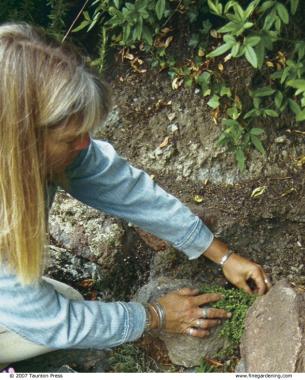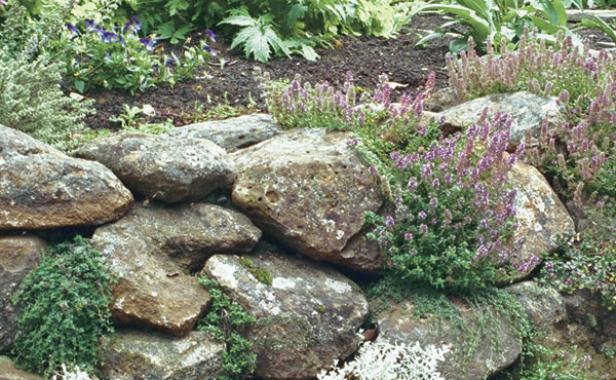
You have to approach building stone walls a lot like you do life. When you hit stumbling blocks, look for creative opportunities. In wall building, those opportunities come when a rock fits well on all sides except one. Instead of launching a futile search for the perfect stone, just leave it alone. After all, the small gaps left from the not-quite-the-right-size rocks create perfect niches for rock-garden plants.
I learned to build walls from David Erdmann, a landscape contractor in Marin and Sonoma Counties, California. He had, in turn, learned the craft as a teenager from an old stonemason working near Lake Tahoe. When David told me that I could put plants in the walls, I queried, “Really? Are you sure they will live?” Well, they did, and this has become my favorite form of wall building. I especially like the way plants settle the walls into the garden, giving them that characteristic, been-there-forever look.
Cover imperfections in walls with cascading plants


Building a finely fitted stone wall is a craft that takes time and persistence to develop. In fact, many people choose not to tackle a stone wall as a garden project because it seems too daunting a task to lift the rocks, let alone to fit the rocks so tightly together. There are no shortcuts to this craft, but there are ways to get around the obstacles.
First, select stones that suit your lifting ability. If you scale the size of the rocks down, building a wall is more like fitting together a jigsaw puzzle. And second, instead of fitting the stones together so tightly, adopt a method practiced in England at the turn of the century: fill gaps with small, crevice-loving plants. For detailed instructions, read Build a Dry-Stacked Stone Retaining Wall.
Rock crevices create a favorable environment for growing plants that would not normally survive in your zone. The plants in these pockets are kept warmer and less waterlogged in the winter, and cooler and moister in the summer. The wall has an overall moderating effect on the climate, providing a perfect place for alpine plants, succulents, and herbs.
Although it’s possible to grow plants in a freestanding wall, retaining walls are better suited for plantings because the earth behind a retaining wall supplies moisture to the planting pockets. They are also easier to build because the soil behind them provides good backing for the wall.
Secure a slope with stones for a modified rock garden


Rather than building a stacked stone wall, you can place a single layer of rock directly onto a slope to prevent erosion and create a modified rock garden. Start by digging a trench approximately 4 inches deep at the bottom of the grade, and secure your largest rocks in this trench. Then place a second course of rocks on top, angling them into the slope. Wiggle the stones back and forth to make sure they will not roll out, then repeat this process as you cover your hillside.
 Retaining walls level a sloped site and provide plenty of places for planting. This wall is filled with fragrant herbs like rosemary and thyme.
Retaining walls level a sloped site and provide plenty of places for planting. This wall is filled with fragrant herbs like rosemary and thyme.
It’s best to plant as you go, filling gaps with loose, loamy soil and an assortment of plants—from larger, spreading plants to smaller, crevice-enhancing ones. Because this approach is not as precise as building a dry-stacked wall, you can use plants with larger root systems. Just be careful placing the next row of rocks so that you don’t damage the roots of your plants.
Small, spreading plants are most suitable
Plants that do well in a rock wall are varied in nature—from small, delicately leaved, creeping plants like woolly creeping thyme (Thymus pseudolanuginosus) or prostrate rosemary (Rosmarinus officinalis); to drought-tolerant plants with minimal root systems like hens and chicks (Echeveria ‘Imbricata’) or other succulents; to tough, forgiving annuals such as wallflowers (Erysimum cheiri), trailing Lobelia erinus, and snapdragons (Antirrhinum majus) that reseed themselves from year to year. Your choice will be dictated by your hardiness zone and the aspect of your wall—whether it faces the sun or is sheltered in shade. You can often push the envelope when it comes to plant hardiness, as retaining walls tend to create a more moderate microclimate.

As they grow, creeping plants will cover much of the wall’s surface, so don’t overplant or you will lose the beauty of the stone. Also, be judicious with prolific spreaders and with plants that reseed themselves abundantly. Here in California, baby’s tears (Soleirolia soleirolii) is the kudzu of the living wall. Once established, it flourishes in every damp crevice, obliterating a wall in a season or two if not controlled.
As a general rule, purchase young plants whose roots will easily fit in the planting pockets. And stick with plants that won’t grow too large as they mature. Not only can large plants look out of proportion growing from a 3-foot wall, but it will be more difficult for large plants to draw the water they need from the soil in small planting pockets. I’d also suggest selecting drought-tolerant plants, as walls are usually quick-draining.
Pack planting pockets with loamy garden soil
To plant a pocket, wedge a small stone into the bottom front of the gap to create a miniature retaining wall that will keep soil from washing out. Next, take some well-amended soil and pack it into the pocket. This soil should be neither too clayey nor too gritty; a loamy soil is best. Ideally, the pocket will open out into the backfill, which will provide added moisture for plants and give their roots room for development. Spread the roots of your plant in the pocket, fill the rest of the hole with tightly packed soil, and water your planting.
You can also add plants to existing walls, but they’ll need to have tiny root systems. Succulents with stems that poke into a hole and then take root are ideal. In time, they’ll form a mat over the rocks. Use a stick or dibble to press soil into these holes, and wedge in a few pebbles to hold the soil in place.
In dry climates, water your plants for best results

One of the nice things about a stacked-stone wall or stone-secured slope is that, because of the angle, rainwater runs into cracks and crevices, reaching plant roots and soaking into the soil. In drier climates or during periods of drought, however, you’ll have to water just as you would any garden.
Over the long haul, the easiest approach is to install an irrigation system. This can be done either as the wall is built or after it has been completed. One option is to run 1/2-gallon drip-irrigation emitters on 1/4-inch tubing behind the wall and into the planting pockets while the wall is being built. The 1/4-inch tubing is then connected to a 1/2-inch line near grade above the wall. Or simply run drip-emitter tubing with 1/2-gallon, in-line drip emitters at 1-foot intervals at surface grade above the wall so that the water seeps into the backfill. Alternatively, spray irrigation (either low-volume, micro-spray heads or pop-up, full-pressure spray heads) can be used to wet the surface of the wall.
I water deeply up to twice a week in dry weather. By using drought-tolerant plants, you may be able to water less often. Get to know the needs of your plants and adjust your watering schedule accordingly. The result will be a lovely, long-lasting, planted wall.
Plants for walls
Perennials for sun
Aubrieta (Aubrieta deltoidea)
Baby’s breath (Gypsophila paniculata ‘Viette’s Dwarf’, G. repens)
Basket of gold (Aurinia saxatilis)
Bellflower (Campanula isophylla)
Blunt-lobed woodsia (Woodsia obtusa)
Candytuft (Iberis sempervirens)
Catnip (Nepeta × faassenii)
Columbine (Aquilegia alpina)
Hens and chicks (Echeveria ‘Imbricata’)
‘Hidcote’ lavender (Lavandula angustifolia ‘Hidcote’)
Moss pink (Phlox subulata)
Pinks (Dianthus cvs.)
Rock cress (Arabis caucasica)
Rosemary (Rosmarinus officinalis ‘Prostratus’)
Snow-in-summer (Cerastium tomentosum)
Stone cress (Aethionema ‘Warley Rose’)
Stone crop (Sedum acre, S. spurium ‘Dragon’s Blood’)
Sun rose (Helianthemum nummularium)
Thyme (Thymus herba-barona, T. praecox, T. pseudolanuginosus)
Perennials for shade
Baby’s tears (Soleirolia soleirolii)
Bellflower (Campanula poscharskyana, C. portenschlagiana)
Columbine (Aquilegia alpina)
Creeping Jenny (Lysimachia nummularia)
House leek (Sempervivum tectorum)
Primrose (Primula × polyantha, P. involucrata)
Rupture-wort (Herniaria glabra)
Saxifrage (Saxifraga umbrosa)
Annuals for sun or shade
Snapdragon (Antirrhinum majus)
Sweet alyssum (Lobularia maritima)
Trailing lobelia (Lobelia erinus)
Wallflower (Erysimum cheiri)

















Comments
Found this useful, thank you.
Log in or create an account to post a comment.
Sign up Log in